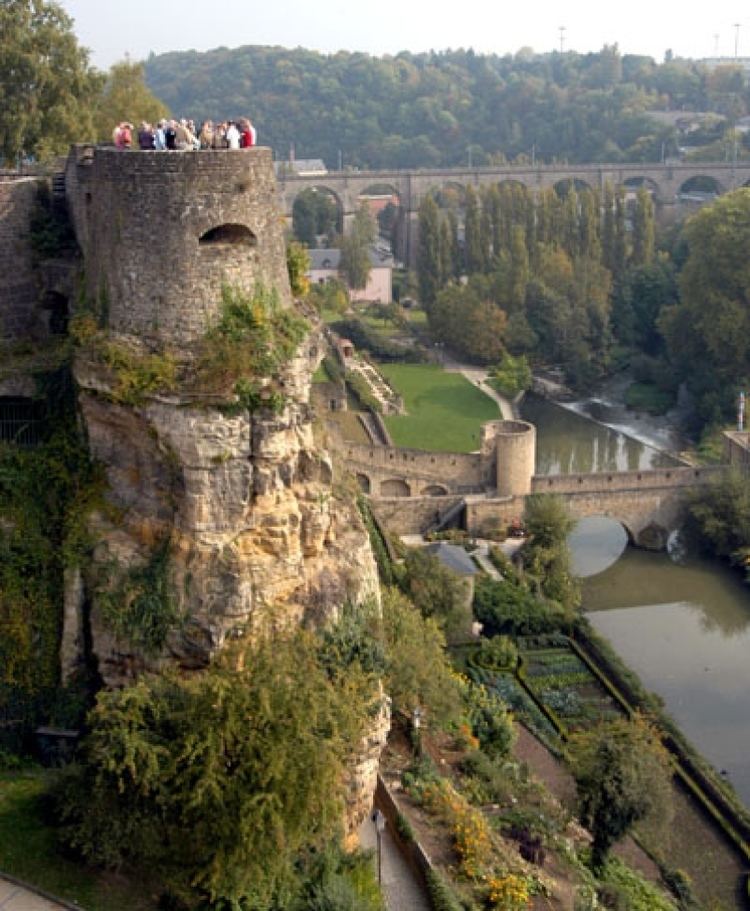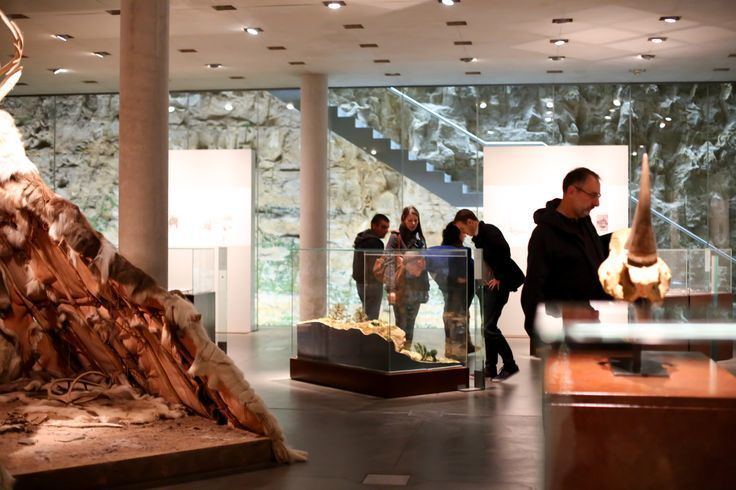Country Luxembourg Population 92,441 (2010) Area 51.46 km2 | District Luxembourg Mayor Lydie Polfer | |
Points of interest Bock, Grand Ducal Palace - Luxembourg, Notre-Dame Cathedral - Luxembourg, National Museum of History and Art, Luxembourg City History Museum Colleges and Universities University of Luxembourg, Sacred Heart University Luxembourg, Conservatoire de Luxembourg | ||
The city of Luxembourg (Luxembourgish: , French: , German: ), also known as Luxembourg City (Luxembourgish: , French: , German: ), is a commune with city status, and the capital of the Grand Duchy of Luxembourg. It stands at the confluence of the Alzette and Petrusse Rivers in southern Luxembourg. The city contains the Luxembourg Castle, established by the Franks in the Early Middle Ages, around which a settlement developed.
Contents
Map of Luxembourg (city)
Luxembourg City lies at the heart of Western Europe, situated 213 km (132 mi) by road from Brussels, 372 km (231 mi) from Paris, 209 km (130 mi) from Cologne.
As of January 2014, the commune of Luxembourg City had a population of 107,247, which was more than three times the population of the countrys second most populous commune (Esch-sur-Alzette). The citys metropolitan population, including that of surrounding communes of Hesperange, Sandweiler, Strassen, and Walferdange, was higher than 165,000.
In 2011, Luxembourg was ranked as having the second highest per capita GDP in the world at $80,119 (PPP), with the city having developed into a banking and administrative centre. In the 2011 Mercer worldwide survey of 221 cities, Luxembourg was placed first for personal safety while it was ranked 19th for quality of living. It is a seat of several institutions of the European Union, including the European Court of Justice, the European Court of Auditors, the Secretariat of the European Parliament, the European Investment Bank, the European Investment Fund, and the European Stability Mechanism.
History
In the Roman era, a fortified tower guarded the crossing of two Roman roads that met at the site of Luxembourg city. Through an exchange treaty with the abbey of Saint Maximin in Trier in 963, Siegfried I of the Ardennes, a close relative of King Louis II of France and Emperor Otto the Great, acquired the feudal lands of Luxembourg. Siegfried built his castle, named Lucilinburhuc ("small castle"), on the Bock Fiels ("rock"), mentioned for the first time in the aforementioned exchange treaty.
In 987 Egbert, Archbishop of Trier consecrated five altars in the Church of the Redemption (today St. Michaels Church). At a Roman road intersection near the church, a marketplace appeared around which the city developed.
The city, because of its location and natural geography, has through history been a place of strategic military significance. The first fortifications were built as early as the 10th century. By the end of the 12th century, as the city expanded westward around the new St. Nicholas Church (today the cathedral of Notre Dame), new walls were built that included an area of 5 hectares (12 acres). In about 1340, under the reign of John the Blind, new fortifications were built that stood until 1867.
In 1443, the Burgundians under Philip the Good conquered Luxembourg. Luxembourg became part of the Burgundian, and later Spanish and Austrian empires (See Spanish Netherlands and Spanish road) and under those Habsburg administrations Luxembourg Castle was repeatedly strengthened so that by the 16th century, Luxembourg itself was one of the strongest fortifications in Europe. Subsequently, the Burgundians, the Spanish, the French, the Spanish again, the Austrians, the French again, and the Prussians conquered Luxembourg.
In the 17th century, the first casemates were built; initially, Spain built 23 km (14 mi) of tunnels, starting in 1644. These were then enlarged under French rule by Marshal Vauban, and augmented again under Austrian rule in the 1730s and 1740s.
During the French Revolutionary Wars, the city was occupied by France twice: once, briefly, in 1792–3, and, later, after a seven-month siege. Luxembourg held out for so long under the French siege that French politician and military engineer Lazare Carnot called Luxembourg "the best fortress in the world, except Gibraltar", giving rise to the citys nickname: the Gibraltar of the North.
Nonetheless, the Austrian garrison eventually surrendered, and as a consequence, Luxembourg was annexed by the French Republic, becoming part of the departement of Forets, with Luxembourg City as its prefecture. Under the 1815 Treaty of Paris, which ended the Napoleonic Wars, Luxembourg City was placed under Prussian military control as a part of the German Confederation, although sovereignty passed to the House of Orange-Nassau, in personal union with the United Kingdom of the Netherlands.
After the Luxembourg Crisis, the 1867 Treaty of London required Luxembourg to dismantle the fortifications in Luxembourg City. Their demolition took sixteen years, cost 1.5 million gold francs, and required the destruction of over 24 km (15 mi) of underground defenses and 4 hectares (9.9 acres) of casemates, batteries, barracks, etc. Furthermore, the Prussian garrison was to be withdrawn.
When, in 1890, Grand Duke William III died without any male heirs, the Grand Duchy passed out of Dutch hands, and into an independent line under Grand Duke Adolphe. Thus, Luxembourg, which had hitherto been independent in theory only, became a truly independent country, and Luxembourg City regained some of the importance that it had lost in 1867 by becoming the capital of a fully independent state.
Despite Luxembourgs best efforts to remain neutral in the First World War, it was occupied by Germany on 2 August 1914. On 30 August, Helmuth von Moltke moved his headquarters to Luxembourg City, closer to his armies in France in preparation for a swift victory. However, the victory never came, and Luxembourg would play host to the German high command for another four years. At the end of the occupation, Luxembourg City was the scene of an attempted communist revolution; on 9 November 1918, communists declared a socialist republic, but it lasted only a few hours.
In 1921, the city limits were greatly expanded. The communes of Eich, Hamm, Hollerich, and Rollingergrund were incorporated into Luxembourg City, making the city the largest commune in the country (a position that it would hold until 1978).
In 1940, Germany occupied Luxembourg again. The Nazis were not prepared to allow Luxembourgers self-government, and gradually integrated Luxembourg into the Third Reich by informally attaching the country administratively to a neighbouring German province. Luxembourg City was liberated on 10 September 1944. The city was under long-range bombardment by the German V-3 cannon in December 1944 and January 1945.
After the war, Luxembourg ended its neutrality, and became a founding member of several inter-governmental and supra-governmental institutions. In 1952, the city became the headquarters of the High Authority of the European Coal and Steel Community. In 1967, the High Authority was merged with the commissions of the other European institutions; although Luxembourg City was no longer the seat of the ECSC, it hosted some part-sessions of the European Parliament until 1981. Luxembourg remains the seat of the European Parliaments secretariat, as well as the European Court of Justice, the European Court of Auditors, and the European Investment Bank. Several departments of the European Commission are also based in Luxembourg.
Geography

The highest points of Luxembourg: Kneiff 560 m Burgplatz 559 Napoleonsgaart 554 m
Culture

Despite the citys comparatively small size, it has several notable museums: the recently renovated National Museum of History and Art (MNHA), the Luxembourg City History Museum, the new Grand Duke Jean Museum of Modern Art (Mudam) and National Museum of Natural History (NMHN). The city of Luxembourg itself is on the UNESCO World Heritage List, on account of the historical importance of its fortifications. In addition to its two main theatres, the Grand Theatre de Luxembourg and the Theatre des Capucins, there is a new concert hall, the Philharmonie, as well as a conservatory with a large auditorium. Art galleries include the Villa Vauban, the Casino Luxembourg and Am Tunnel.

Luxembourg was the first city to be named European Capital of Culture twice. The first time was in 1995. In 2007, the European Capital of Culture was to be a cross-border area consisting of the Grand Duchy of Luxembourg, the Rheinland-Pfalz and Saarland in Germany, the Walloon Region and the German-speaking part of Belgium, and the Lorraine area in France. The event was an attempt to promote mobility and the exchange of ideas, crossing borders in all areas, physical, psychological, artistic and emotional.
Luxembourg City is also famed for its wide selection of restaurants and cuisines, including four Michelin starred establishments.
Places of interest
Places of interest include the Gothic Revival Cathedral of Notre Dame, the fortifications, the AM Tunnel (an art gallery underground), the Grand Ducal Palace, the Gelle Fra war memorial, the casemates, the Neumunster Abbey, the Place dArmes, the Adolphe Bridge and the city hall. The city is the home of the University of Luxembourg and RTL Group.
The Second World War Luxembourg American Cemetery and Memorial is located within the city limits of Luxembourg at Hamm. This cemetery is the final resting place of 5,076 American military dead, including General George S. Patton. There is also a memorial to 371 Americans whose remains were never recovered or identified.
Luxembourg (city) cuisine

Luxembourg has many delicacies. In addition to French patisseries, cake and fruit pies, local pastries include the Bretzel, a Lent speciality; Quetscheflued, a zwetschge tart; verwurelt Gedanken or Verwurelter, small sugar-coated doughnuts; and Appelklatzen, apples en croute. Luxembourgs cheese speciality is Kachkeis or Cancoillotte, a soft cheese spread.
Fish from the local rivers such as trout, pike, and crayfish are the basis for dishes such as Frell am Reisleck (trout in Riesling sauce), Hiecht mat Kraiderzooss (pike in green sauce) and Kriibsen (crayfish), usually prepared in a Riesling sauce. Another favourite is Fritur or Friture de la Moselle, small fried fish from the River Moselle, accompanied by a local Moselle white wine.
Meat dishes include cold Eisleker Ham, literally Oesling ham, from the mountainous north of the country, first marinated for a couple of weeks and then smoked for several days. It is usually served thinly sliced with chipped potatoes and salad. Perhaps the most traditional of all Luxembourg meat dishes is Judd mat Gaardebounen, smoked collar of pork with broad beans. The pork is soaked overnight, then boiled with vegetables and spices. Served in copious slices together with the beans and boiled potatoes, it is considered to be the national dish of Luxembourg. Hong am Reisleck, similar to the French Coq au Riesling, consists of browned chicken pieces simmered in white wine with vegetables, spices and mushrooms. Huesenziwwi or Civet de lievre is a jugged hare dish served during the hunting season.
Other dishes include liver dumplings (quenelle) with sauerkraut and boiled potatoes, Traipen (black pudding) with apple sauce, sausages with mashed potatoes and horseradish, and green bean soup (Bouneschlupp). French cuisine is featured prominently on many menus, as well as certain dishes from Germany and Belgium.
